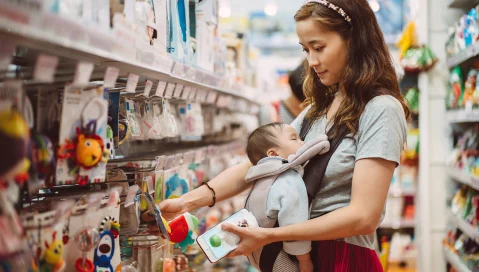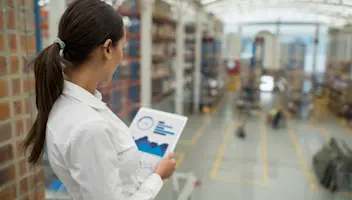Featured in this post
The Store of the Future: 10 Ways To Make People Love Shopping Again
The Store of the Future: 10 Ways To Make People Love Shopping Again
23 Nov 2022
Aptean Staff Writer
Rekindling the love of shopping means reconnecting with consumers’ desire for a tactile, social and enjoyable experience in today’s omnichannel retail environment. People use their leisure time less frequently for shopping than they used to. Appealing to their desire for convenience is key to bringing them back into stores.
With in-store shopping losing out to an increase in online sales, learn these ten ways retailers can put the passion back into successfully enticing people into stores.
1. Make It Friendlier
Customer service has a significant impact on the shopping experience.
Many online retailers have grasped the importance of customer service for winning and retaining customers. Omnichannel systems can provide the information that facilitates staff to provide good customer service—being able to provide product offerings and stock availability are just some prime examples. It’s time that stores retrained their assistants, particularly on technology that can improve the shopping experience, if they want to keep up with online retailers.
With studies finding 69% of shoppers prefer to get information on their smartphones rather than speak with sales assistant, a UK electrical retailer gained a lot of attention when it changed the way it rewarded floor staff. Instead of winning commission on sales, staff now receive a bonus linked to customer satisfaction. The shift marks changing customer demands. People no longer want a hard sell—instead they want helpful information when they ask for it.
2. Make It Easier
Successful omnichannel retailing blends the best online and brick-and-mortar retail experience—making it easy and enjoyable for shoppers. Store pickup is proving to be hugely popular, offering customers added convenience to collect their goods instead of arranging to be at home for delivery.
The ability to promote in-store offers directly to customers when they enter the store has also become a trend among retailers. With retailers now making 40% of sales online but with 90% of customers still shopping in store, Sephora is just one of several retailers pushing promotional messages and notifications via an app to customers’ smartphones when they come within a certain radius of a nearby store.
The technology offers customers a free service, which incentivizes them to enter a store and increases the likelihood of them making a purchase. Could it get any easier?
3. Take Advantage of Technology
Sales staff with portable technology, such as tablets or wireless headsets are an increasingly common sight, allowing staff to answer questions or access stock information much faster. Shoppers are also able to make immediate purchases as they can make transactions anywhere in the store. This improves on the day conversion rates. More than a third of shoppers think that sales staff should be equipped with tablets to help them answer questions faster and more accurately.
Omnichannel retailer, John Lewis, is taking technology so seriously that it’s launched a technology incubator: JLAB. The company is using Beacon technology to give customers access to specific services based on their precise location in the store.
Target is another retailer leveraging this new Beacon technology and are using it to create a GPS system for a customers shopping cart. It allows in-store customers to create shopping lists and see where the items they want are located—as well as their own proximity to the product. As they move around the store, their location on the GPS system changes and shows how far away, or near, they are to their desired product.
4. Make It Seamless
The generation that’s grown up with the internet sees little distinction between buying online and offline. Their shopping journey might start on a tablet, then a smartphone and only then in-store. What they want is a consistent experience with no barriers between channels. This connected shopping experience can be achieved by offering apps where customers can add something to their basket at home before coming in-store to purchase it.
5. Offer Choice
Choice is an exciting part of the shopper’s experience. So any barriers to this act as a considerable deterrent. Some retailers are using mobile technology to expand their product offerings without reducing already limited floor space. The retailers’ full eCommerce range is then available in-store.
Choice is about more than just the mix of goods on the rail or on the shelf—it includes delivery options and even access to WiFi for online comparison. In fact, four out of ten people say the availability of free WiFi influences the choice of where they shop.
To boost choice, successful retailers must have chain-wide visibility of stock and have cut delivery times to within two or three days which is good news considering as much as half of all online shoppers have abandoned transactions because the delivery options did not meet their needs.
6. Embrace Storytelling
Marketers have grasped the power of the story to connect with customers. Apple harnessed the power of storytelling long before it got into retail. And its stores only reinforce the minimalist "we are different" theme, with details like roaming and wireless checkouts drawing the customer into the brand story.
Aldi’s down-to-earth, "real" people advertising is part of the same storytelling narrative, with a solid connection to its practical, no-nonsense in-store experience.
Give customers a happy ending to their shopping experience, and they’ll keep coming back for more.
7. Keep It Dynamic
Change and variety are essential to an exciting retail experience. Today’s concept stores offer a technology-rich blend of entertainment, interaction and shopping. Making retail a destination, not a chore.
Fashion retailer, Forever 21, uses a 61-foot wide outdoor billboard to project interactive content and engage people as they walk outside the store—enticing them to stop and pose for a picture. The captured images are then shown on the screen and visible to the outside crowd. For a retail brand looking to engage with its customers and generate more sales, this is a sure fire way to achieve that.
8. Make It Faster
Queue-busting technology unlocks sales currently being lost. Fully transactional in-store portable, hand-held technology allows customers to make transactions anywhere in the store.
At the same time, kiosks offer a dedicated ordering point in-store—reducing waiting in line for checkout and increasing customer satisfaction. Three out of four shoppers say queuing is the worst part of in-store shopping and will abandon their purchase before the register if the wait is more than five minutes.
9. Make It Personal
People love products that are made for them and picked for them. Personalized products don’t need to be unique, but they do need to be presented in just the right way—and at just the right time. This means understanding the customer at a whole new level.
Social media and email are just some of the many channels used to deliver personalized offers and information direct to the consumer. The use of data capture in-store means that customers can be targeted with relevant offers more effectively, increasing the likelihood of making additional purchases.
Wayfair, a home-furnishing retailer, harnessed the power of social media to showcase and sell its products online. Using social platforms, the company offered followers tips, home décor inspiration and promotions. Making the customer experience easy and convenient, all within the click of a few buttons.
10. Keep It Real
One size doesn’t fit all.
Imperfection is a reality.
And that’s okay.
Online retailers have embraced the practice of publishing customer reviews, warts and all, because it gives a competitive advantage.
M&S uses digital kiosks giving customers access to videos and product reviews. Some retailers use digital labels that can hold QR codes that could provide links to product information and reviews if scanned in real-time while shopping.
Even in the post-pandemic landscape where online experiences and direct-to-consumer models continue to dominate, you can encourage your customers to love in-store shopping again in no time with these ten steps. And, by investing in your in-store experience, you can promote deeper brand loyalty and consistency across all of your channels—a critical strategy to stand out in the crowded market and find lasting success.
To empower your business on this path to growth, you'll need the right software in your corner to streamline processes and enable improvement strategies. Enter Aptean.
Our comprehensive retail software suite is designed to help businesses just like yours unlock the next level of customer experiences while improving efficiency and reducing costs. Our platform includes:
An industry-specific retail ERP providing a 360° view of customer behavior to help you maximize your multi-channel retail operation
Our PLM built for retail businesses to streamline every step of your product development process
A complete retail planning platform with tools for allocation, forecasting and replenishment and assortment planning as well as profitability planning
And that's not to mention the range of complementary solutions in our suite such as our advanced transportation management solutions, our payment processing software and our powerful business intelligence tool.
So wherever you are in your journey, we're ready to partner with your business and help you drive profitability. If you're ready to discover how Aptean's retail solutions can help transform your multi-channel retail operations get in touch with one of our experts to find out how, now.
Related Content


Ready to start transforming your business?
We’ve got the specialized ERP solutions you need to conquer your industry challenges.






